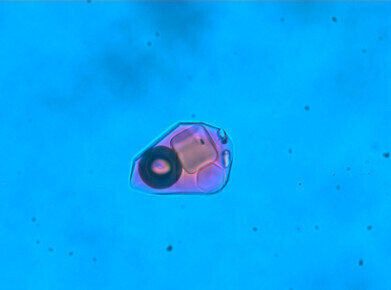-
 This is a multiphase brine inclusion image (approximately 30 microns in length) from the Boyongan copper-gold porphyry deposit in the Philippines. In addition to a high salinity aqueous solution it contains a round vapour bubble, a large halite (NaCl) cube, a smaller sylvite (KCl) cube and several other 'daughter' crystals that have crystallised during cooling of the fluid after high temperature entrapment.
This is a multiphase brine inclusion image (approximately 30 microns in length) from the Boyongan copper-gold porphyry deposit in the Philippines. In addition to a high salinity aqueous solution it contains a round vapour bubble, a large halite (NaCl) cube, a smaller sylvite (KCl) cube and several other 'daughter' crystals that have crystallised during cooling of the fluid after high temperature entrapment.
Microscopy & Microtechniques
Report on Temperature- Controlled Microscopy to Study Inclusions in Mineral Deposits
Aug 17 2018
Dr Wilkinson, Research Leader in Mineral Deposits in the Department of Earth Sciences at the Natural History Museum, London, has worked with various Linkam stages for more than 20 years starting with his PhD research work at the University of Southampton. The Linkam temperature stages are used to study fluid inclusions - microscopic droplets of liquid that can be trapped inside growing crystals when they form in the Earth. These are typically just a few tens of microns in size, thus requiring microscopic methods for their investigation, and may have formed millions or even billions of years ago. By freezing and heating these inclusions, it is possible to obtain information on the composition, density, temperature and pressure of entrapment of the fluid - information that provides critical constraints on the conditions of crystal growth. In ore deposits, this information can tell a researcher about the temperature at which the ore minerals formed, their depth of formation beneath the Earth's surface and something about the fluid composition, in particular how salty it is, and also whether it contains dissolved gases like methane or carbon dioxide. Data like this can be critical in distinguishing between different mechanisms for ore formation.
Dr Wilkinson discusses the benefits of working with Linkam and their temperature stages. “I have become more and more impressed with the Linkam family of temperature-controlled stages. They provide precise and accurate measurement capability, are designed with a small thermal mass so respond quickly and require small temperature calibration corrections. Not least is their ease of use (particularly where inexperienced undergraduate students are concerned). All are equally important to us.”
An example of Dr Wilkinson's research is presented in a paper that documents data gathered over a number of years to demonstrate a new method for the estimation of salinity in aqueous fluid inclusions. In discussing the design of Linkam's stages, Dr Wilkinson said “the thermal masses of the stages (heating block and sample holders) are small and hence thermal equilibration rates are clearly very fast. This is evidenced by the virtually immediate response of an inclusion to a small step in temperature when close to a phase change such as final ice melting or CO2 phase homogenisation. Linkam's stages were ideal for this work.”
For information on Linkam’s range of temperature-controlled stages along with other temperature and environmental materials characterisation solutions, please click here.
Digital Edition
International Labmate 49.6 - Sept 2024
September 2024
Chromatography Articles - HPLC gradient validation using non-invasive flowmeters Mass Spectrometry & Spectroscopy Articles - From R&D to QC, making NMR accessible for everyone: Putting NMR...
View all digital editions
Events
Oct 30 2024 Birmingham, UK
Oct 30 2024 Manchester, UK
Nov 11 2024 Dusseldorf, Germany
Nov 12 2024 Cologne, Germany
Nov 12 2024 Tel Aviv, Israel


















